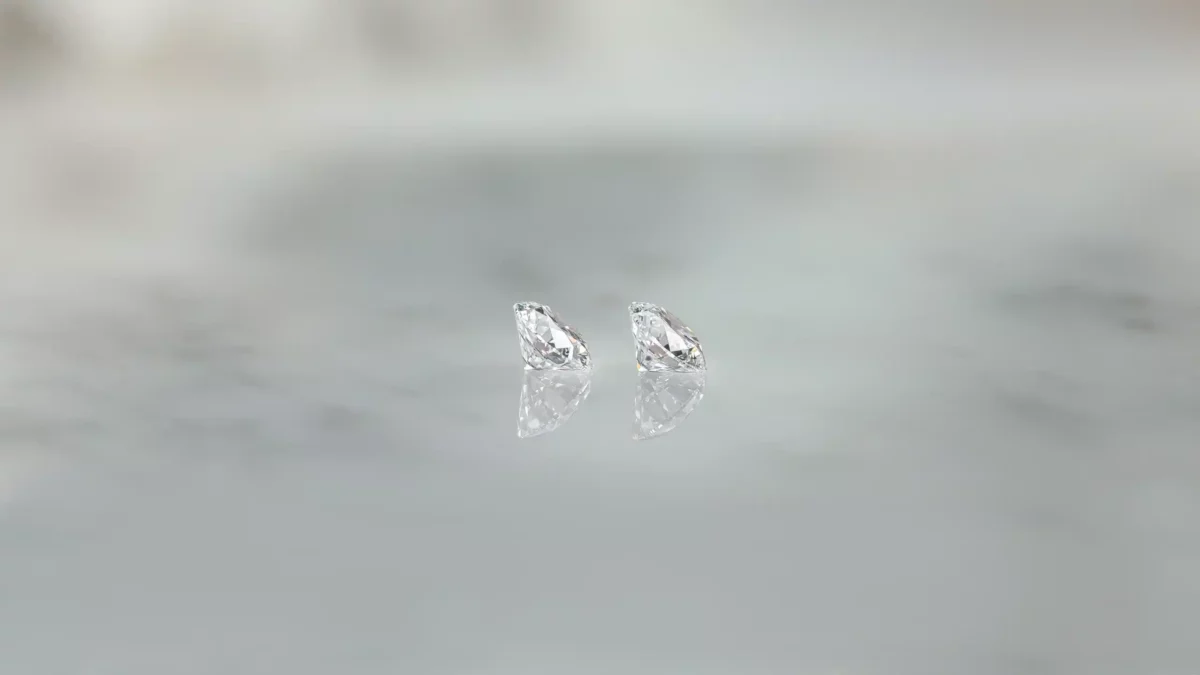
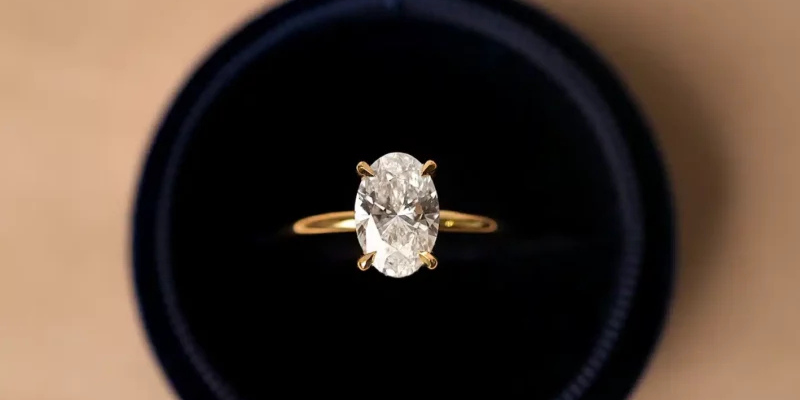
How much should you spend on an engagement ring? While social media and celebrity engagements showcase massive sparklers, that’s all well and good for those with a cool $1 million to spend. What we really want to know is, how much does the average Australian spend on an engagement ring?
We launched Australia’s biggest Engagement Ring Survey to get all the details. We asked how much people spend on their engagement rings, which style of engagement rings is the most popular, who pops the question, and how happy people are with the ring on their finger.
Take a look at the results of our survey below before setting your own budget for the perfect diamond ring.
Not surprisingly, diamond engagement rings remain the most popular choice for engaged couples. We found that 80% of engagement rings feature a diamond, while sapphire is the second most popular stone.
Morganite is a relative newcomer to engagement rings but has been gaining popularity in the past two years. The results confirm this, with 2% of engagement rings featuring a morganite stone.
Our survey recorded over 50 different stones in total. This shows that there aren’t any rules when it comes to choosing the perfect engagement ring.
When it comes to the style of cut, the timelessness of a brilliant round cut diamond was the clear winner, making up 47% of modern stones.
What’s interesting, however, is that this is down from 65% about 10 years ago. It goes to show that people are embracing a larger variety of stone cuts. In fact, princess cut diamonds are twice as popular now than 10 years ago.
And the survey also showed a small number of people are choosing to forgo a large central stone for a cluster of smaller stones placed together to mimic a traditional cut diamond. This is a great way to make the most of your budget and maximise the sparkle factor.
We also found people are buying larger diamonds now than they did previously. Twice as many people had bought a one-carat diamond or larger over the past two years, compared to 10 years ago.
Overall, there was an even mix of stone sizes mentioned in the survey with 55% of engagement rings containing stones between 0.5 carats and 0.90 carats. At the other end, there were 16% of engagement rings with a stone larger than 1.2 carats.
For the ring itself, our survey recorded a staggering 20 different types of metal. The three most common were white gold (49%), yellow gold (30%) and platinum (9%). Two-toned, a combination of white and yellow gold, made up 5% of rings.
Drum roll, please! When it comes to engagement ring styles, a diamond in a white gold setting was the standout, with 49% of our survey respondents choosing this combination. Diamond and yellow gold engagement rings came in second, with 25% of engagement ring styles.
Because both these styles are so popular, it can be easier to narrow down your choices as you start searching for an engagement ring.
The most popular design for the stone itself was the ‘halo’ setting, which features a large middle stone surrounded by smaller stones. This design has become more popular over the past ten years.
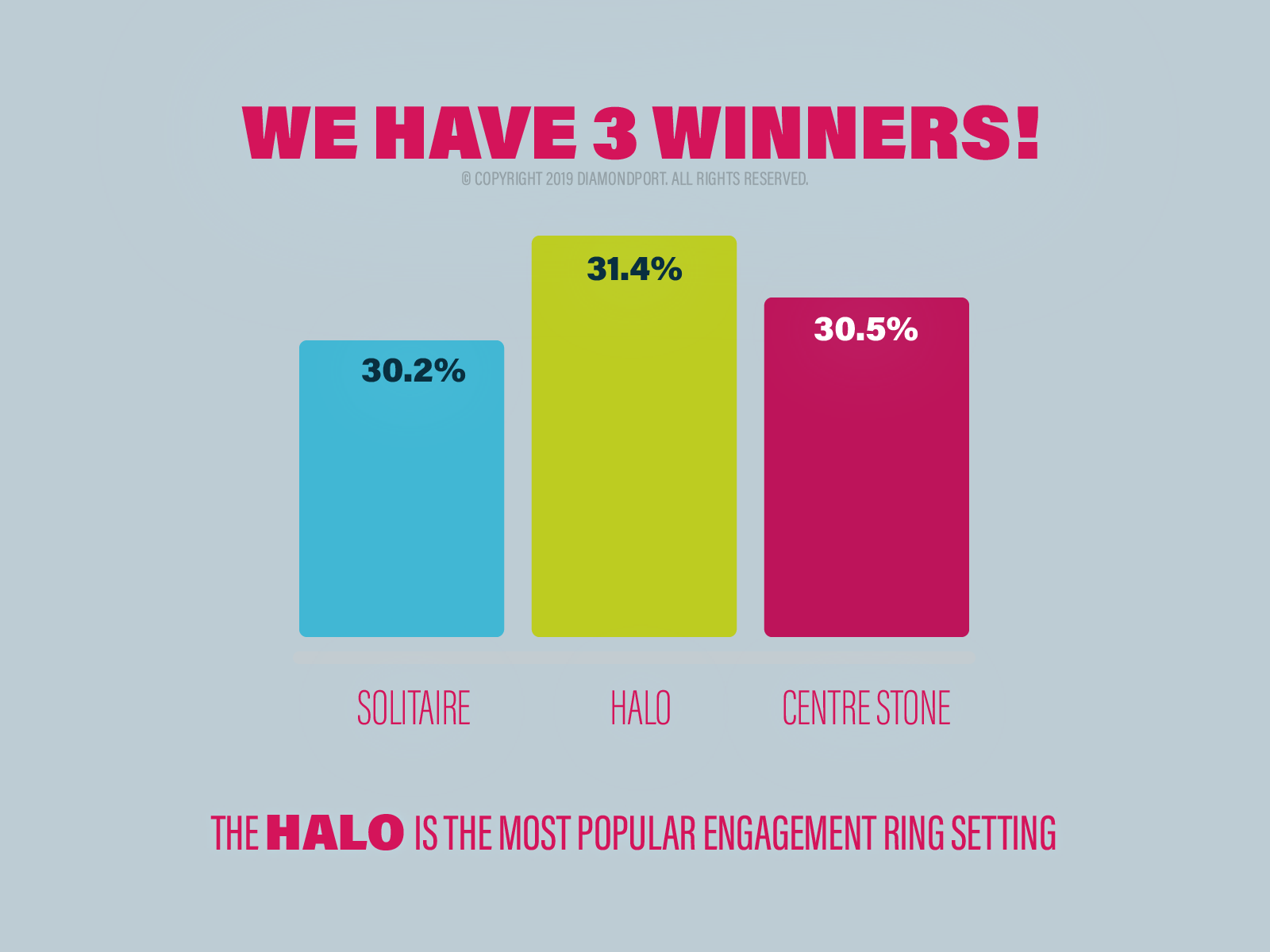
A three-stone or trilogy design was the second most popular setting. This is an elegant style that pairs beautifully with a diamond wedding band for a complete look.
This setting was closely followed by the classic solitaire ring which has a single centre stone on a plain metal band. A solitaire engagement ring is a timeless design and we’re confident it’ll never go out of fashion.
Almost half of the survey respondents said ring design was the most important criteria when buying their engagement ring. Price (20%) and quality (24%) were also important considerations behind quality.
Now we’re getting to the fun details – who proposed to who, how and with what. 80% of proposals were made using the actual engagement ring, while 20% were done using a stand-in ring or no ring at all.
So, who’s asking? Unsurprisingly, our male respondents made the overwhelming number of proposals. Of the men we surveyed, they popped the question 85% of the time. While women surveyed proposed 10% of the time. But most interesting is that of everyone we talked to, 5% said the proposal was mutual.
So, with men proposing most of the time using the actual engagement ring, it seems their partners are letting them know what type of ring they’d like and leaving it to the man to plan the actual proposal.
It seems many are still buying rings the “old fashioned” way, with 84% visiting at least one jeweller, with 20% visiting four or more jewellers before deciding on the perfect ring.
What’s most interesting, is the amount spent on an engagement ring increases with the amount of research done by the purchaser. As people learn more about what goes into a quality engagement ring, they see value in spending a bit more. It could also suggest those with a larger budget want to make sure their money is well spent, and do more research.
Let’s talk dollars. First up, we should start with a budget. Most people have a budget in mind when they set out to buy an engagement ring. Of the people who had a budget at the outset, 77% stuck to it when buying the engagement ring.
According to our survey, the average amount spent on an engagement ring in 2019 was $5,297.50. An increase from $2,579.65 about 10 years ago.
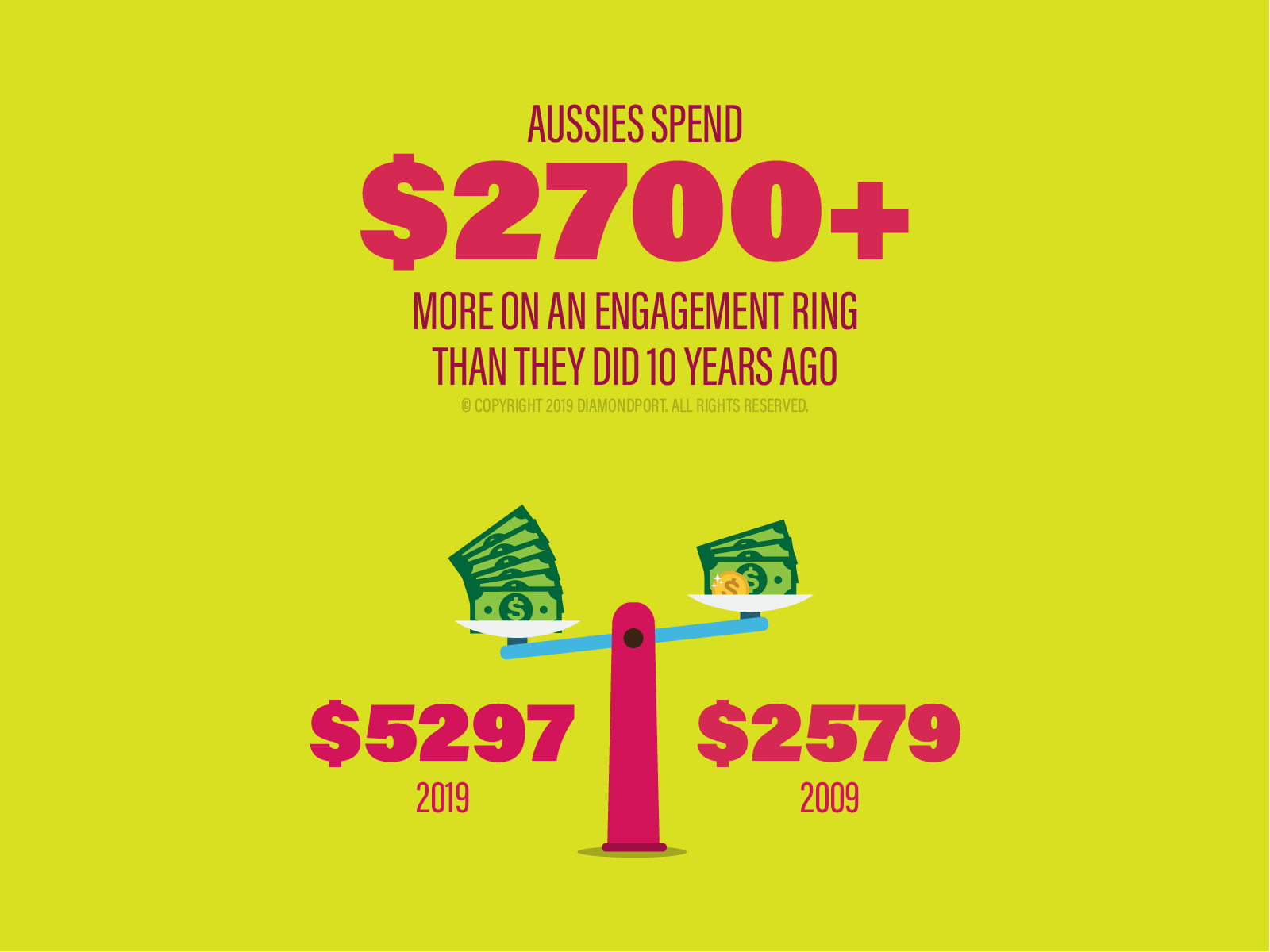
4% of survey respondents spent over $20,000 on their engagement ring, and 1.5% spent over $25,000.
While everybody is aware of the ‘engagement salary rule,’ our survey respondents were pretty divided on what the rule actually is. We found that 20% of people think the rule is to spend one month’s salary, and 70% think the rule is three months’ salary.
From our research, it seems the rule was originally three months until the 1930s Depression, when De Beers Diamonds, feeling a pinch in diamond sales, suggested men scale back and spend one month’s salary instead.
At the end of the day, these ‘rules’ for buying an engagement ring were devised generations ago, when people married younger, home ownership was more affordable, and salaries were more uniform. It shows in the numbers—72% of people completely ignore any ‘rule’ when buying their engagement ring.
There is a small but reliable relationship between annual income and ring cost. However, as we review the data, some individual cases highlight specific outliers. Some people on low incomes save and spend more than the average, while others on higher incomes spend less than their peers.
It’s no longer safe to assume that the male (or just one partner) is solely responsible for paying for the engagement ring. In our survey, both people contributed to the cost of the engagement ring 20% of the time.
This could mean a few things:
What we love is that when both partners pay for the ring together, one partner still plans the proposal 72% of the time. It shows that even when you’re financially responsible, there’s still room for romance.
Most of all, we’re all pretty happy with our engagement rings.
It sounds like we are very happy with our rings! Over 80% report they are happy or very happy with their engagement ring, no matter how much it cost or what the cut of the stone is.
People with diamond engagement rings are 8% happier than those with another stone type. But this isn’t a significant reason not to go ahead and explore other stone types if that’s what you want.
But some people choose to update or upgrade.
Updating and upgrading engagement rings has become more common, with 7% of respondents reporting updating or upgrading since marrying. However, not all survey respondents were married yet, so this percentage is likely higher in reality.
You’ve seen the data; now, you need to figure out a budget that’s right for you. We sum up our best advice to ensure you find the perfect ring at the right price.
To find the right jeweller, there’s no better review than a recommendation. Ask recently engaged friends who they used.
“There are no hard and fast rules anymore, dictating how much you should invest in your engagement ring,” says Ashley Portas, Diamondport founder.“It’s a personal decision, and there’s no shame in prioritising other financial commitments such as home ownership or travel. I’m privileged to meet all sorts of wonderful people who are ready to get married. Some guys can invest in incredible jewellery, but I’ve also been lucky enough to create beautiful diamond rings for people who weren’t sure what they could afford.”
At every price point, whether your budget is relatively modest or generous, Diamondport is able to create a ring that surpasses expectations and is better value than you’d find at high-street stores.
Be realistic in your budgeting so that you buy a beautiful diamond ring without any stress. Your partner deserves the best you can afford – not the burden of a huge credit card debt. Figure out what you can afford and stick to it. A great jeweller will find something you love without breaking the bank.
At Diamondport, we’re in the business of selling exquisite diamonds, and we love it. But we know there’s plenty of other exciting things happening in your life; maybe you’re buying a house, planning an engagement proposal or party, paying for an incredible wedding, travelling, or starting a family. These are significant expenses that will bring you joy.
If you are debating how much to spend on an engagement ring, consider how much you value it compared to all the other exciting things you are planning.
Some jewellers will sell diamonds that appear great on paper but are a bit lacklustre on your finger. Diamonds can tick all the GIA boxes, commanding a high price, yet have quirks that should see them discounted. We’ve written a whole eBook on the subject – you can download it for free. Hence, it’s best to find a trustworthy diamond expert with access to the highest quality stones.
Buy the best diamond you can afford and design a ring around it. Design the right ring for your budget. Complex designs cost more, so consider an elegant solitaire if you’re on a budget. Solitaire rings are sophisticated, timeless and chic, and their relatively simple design means they cost less to create.
If you’re thinking about popping the question, then hopefully you’ve learnt something about engagement ring trends in Australia’s Biggest Engagement Ring Survey.
In addition to doing your research, listen to your partner’s hints and suggestions—we can almost guarantee they’ll be dropping some! Then, consider your priorities and budget to find the perfect engagement ring for you and your partner.
Book a consultation with us today to begin creating your dream engagement ring with Brisbane’s premier engagement ring jeweller. Conveniently located in the Queen Street Mall, we’ll even organise parking, so you enjoy this special moment – finding the perfect engagement ring.
Explore Rings by Cut
Explore Rings by Style
Explore Rings by Type
Services & Community
About
Contact Us
Diamondport Jewellers supports diversity in all its forms.
We acknowledge the traditional owners of the land of which we work here at Diamondport Jewellers and pay our respects to the Turrbal people and their elders both past and present.
Address: Suite 402, Level 4,
180 Queen Street, Brisbane City, 4000
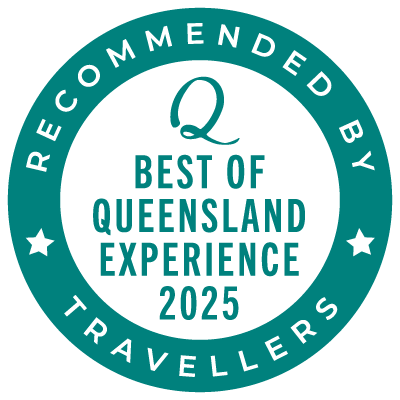



Diamondport Jewellers supports diversity in all its forms.
We acknowledge the traditional owners of the land of which we work here at Diamondport Jewellers and pay our respects to the Turrbal people and their elders both past and present.